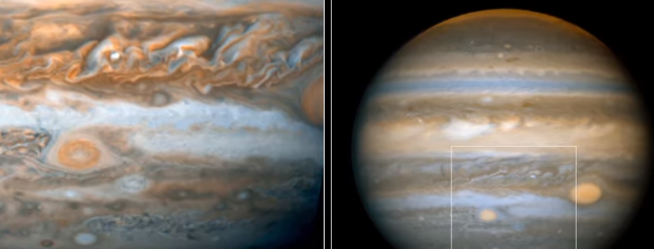What if Jupiter, the solar system's main gas giant, is "sick"? Of course, this is anthropomorphic. Jupiter does have some big red dots, and those dots are bigger than the Earth! But what exactly causes it? Today we are going to talk about what's wrong with Jupiter. How many red dots are there on Jupiter? How deep is this huge abscess? Finally, why doesn't the mysterious big red dot disappear?
In order to make a correct diagnosis, the exact date of onset of Jupiter's "disease" must be determined. So when the big red dot was formed, In the above sketch, made by Italian astronomer Giovanni Cassini in 1665, the blob doesn't look very big, just dark. However, in a painting by the Italian painter Donato Critti, it became colorful. The ignorant public sees it as a strange ocean or the top of a huge volcano. However, astronomers immediately realized that this was the vortex of a massive storm.
But careful scientists have discovered that if we look at old paintings and drawings, why we see the blob in Jupiter's north, rather than in the southern hemisphere, is not the same location as before the Great Red Spot. Apparently, no Red Spot can cross Jupiter's equator, and this inconsistency has led some past scholars to suggest that the current Great Red Spot is the second in the past 400 years. How the first Great Red Spot disappeared and how this one emerged, we have absolutely no idea, because we missed it. After all, there was a decades-long observation gap, but in theory the answer is much simpler.
In some old telescope observations, the optical properties of the data were so bad that no one thought to adjust it until the end of the 19th century. The Great Red Spot is still in Jupiter's north, and it appeared no later than the mid-17th century. The Voyager probes arranged the first high-quality images of the Great Red Spot in the late 1970s. At the time, astronomers noticed that the Great Red Spot was slowly but surely moving along Jupiter's surface, much like a superstorm on Earth.
The land-based hurricane Irma, which occurred in 2017, was so similar to the Big Red Dot that they even rotated counterclockwise in the same way when viewed from space. However, even the most violent hurricane on Earth can't match the strength of the Big Red Dot. With wind speeds of up to 650 kilometers per hour, they are a fungiform storm of hydrogen, ammonia, and sulfur compounds that can hold a half-Earth in all its hurricanes, but the most striking difference is the nature of the Jupiter storm.
The typical tropical storm that hits Florida or Mississippi is a funnel with a central area of low pressure, while the Great Red Spot is an anticyclonic pressure on Earth with a high central height. In fact, in infrared images, the Great Red Spot is significantly cooler than the atmosphere around Jupiter, except that any winter anticyclone on Earth typically lasts a few days, rather than centuries like the Great Red Spot 39bet-xsmb-xổ số tây ninh-xổ số binh phước-xổ số binh dương-xổ số đồng nai. Scientists believe that because Jupiter is a gas giant, there is no solid surface to slow down terrestrial storms. Oddly, though, a similar big black spot on Neptune lasted only five years, while Saturn's big white spot appeared every 30 years and eventually disappeared without a trace. Only Jupiter's big red spot lasted for hundreds of years. Thus, even the nature of gas giants cannot explain why the big red dot on Jupiter becomes so large and insoluble!
Beyond that, scientists never understood why it was so red. On the surface, it looks like the storm is made of exactly the same gas as the light brown Jupiter cloud, but if we get close to it, we might see red spots like scabs on a wound, which is exactly what chemists believe. According to them, a huge cyclone will organic compounds from Jupiter's deep into the upper atmosphere. These compounds will not eventually arrive there. Under the influence of the sun's ultraviolet radiation, they formed a substance called through the forest. The substance has a unique deep shades of red and the same color Lin.
In some early images, the Great Red Spot was so huge that it could hold three Earths at once. This is not an exaggeration. Using the Hubble Telescope, we observed the oval Great Red Spot, which gradually became smaller and rounded. For 30 years, at the same time, pieces of debris the size of North and South America combined have periodically flaked out of the vortex. Some scholars thought Jupiter's Great Red Spot would dissolve on its own within the next 20 years, but instead, wind speeds along its edges are increasing. It doesn't look like a weakening storm, so what exactly is hidden beneath the Great Red Spot?
To unravel what lies beneath the Great Red Spot, you have to get closer and deeper. To launch a probe from our space station, we'd have to fly over the Great Red Spot, or even get hundreds of kilometers above it. But in 2017, the Juno spacecraft felt a huge tug as it approached, and as it flew over the Great Red Spot, its radio signal was distorted as if it had hit a giant gravitational pocket, meaning there was a huge mass concentration beneath the surface of the spot. It's as if another planet is hiding at the center of Jupiter's biggest storm. But what exactly is it?
 As Juno descends to the red spot, the thermometer column on the probe also turns red. Temperatures will rise from Jupiter's record low of -172 degrees to a high of 226 degrees. At extreme temperatures 220 kilometers deep, it's almost like the difference between liquid nitrogen and molten tin. The bottom of the storm used to be thought to be shallow underground here, however, microwave studies of Juno show that the giant red dot penetrated at least 500 kilometers deep into the gas giant's atmosphere.
As Juno descends to the red spot, the thermometer column on the probe also turns red. Temperatures will rise from Jupiter's record low of -172 degrees to a high of 226 degrees. At extreme temperatures 220 kilometers deep, it's almost like the difference between liquid nitrogen and molten tin. The bottom of the storm used to be thought to be shallow underground here, however, microwave studies of Juno show that the giant red dot penetrated at least 500 kilometers deep into the gas giant's atmosphere.
Based on Juno's data, some scientists have concluded that temperatures should be even higher. Maybe if we sent a well-protected probe to the Great Red Spot, the jet stream that fuels it, we could detect it at a depth of 3,000 kilometers. It turns out that the Great Red Spot is a giant superheated atmospheric engine that, for some reason, doesn't lose centuries of energy. In other words, it's not just an abscess on Jupiter's body, it's a tumor that affects many tissues and feeds on its juices.
In the late '90s, a similarly structured atmosphere appeared in several of Jupiter's smaller vortices. NASA named it the "Little Red Dot," and its development has been closely monitored ever since. Who knows, when the bright red tumor on the planet dissolves, this newcomer will replace it, or do you think Jupiter will eventually be covered in black spots in the next few decades?
